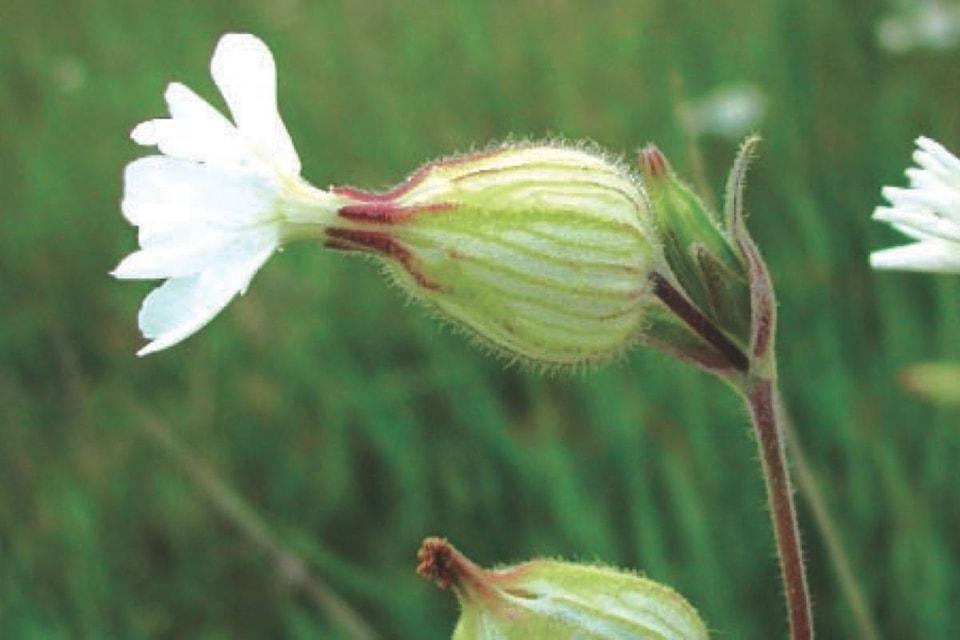White cockle is a short-lived perennial (sometimes biennial) native to Europe. Plants are either male or female, so not all plants produce seed.
Identification
Stems: stems are hairy, grow 30 to 120 centimeters tall, and can be erect or spread laterally. There can be several stems per plant and crowded plants branch in the upper stems. Stems are swollen at the nodes.
Leaves: leaves are opposite, hairy, and lance or slightly oval-shaped with pointed tips. Basal leaves and upper stem leaves are smaller.
Flowers: flowers are numerous, fragrant and arranged in spreading clusters. The white (or pinkish) flowers have five notched petals and only open in the evening. The sticky, tubular calyx surrounds the flower’s base. The calyx of the male flower has 10 veins, and the female’s 20 veins are longer, and inflate with ripening.
Seeds: the calyx matures into a fruit with 10 teeth at the tip containing many tiny, grayish seeds.
Control
White cockle can be a serious economic problem as its seeds are difficult to separate from alfalfa, clover and some grass crop seeds – and this invader is an extremely heavy seed producer. This plant emerges early spring, initially forms a taproot, and next spreading lateral roots.
Cultivation: stem and root pieces can sprout to form new plants; therefore cultivation will usually spread an infestation.
Mechanical: frequent mowing will reduce seed production.
Chemical: Mecoprop (in a product mix with 2,4-D and Dicamba) and Tribenuron-methyl (alone or in a product mix with Metsulfuronmethyl and quinchlorac) are registered for use on white cockle. Always check product labels to ensure the herbicide is registered for use on the target plant in Canada by the Pest Management Regulatory Agency. Always read and follow label directions.
Consult your local agricultural fieldman or certified pesticide dispenser for more information.
Why field scout?
(Alberta Agri-news)
Field scouting throughout the growing season can lead to more successful crop production.
“There are numerous factors that can impact a developing crop,” says Mark Cutts, crop specialist, Alberta Ag-Info Centre. “Scouting can help producers understand what is happening in their fields and aid them in making proper management decisions. At this time of the year, for example, producers can evaluate various agronomic components including plant stand establishment, weed control, diseases and insect pests.”
Evaluating the plant population for a given crop lets producers see if the number of plants (per square foot or square metre) matched the target goal that was established at the time of seeding. “For producers that used a seeding rate calculator, their target plant population would be known. If, after sampling multiple locations in the field, the plant stand is lower than expected, producers can start to investigate the reasons for the lower stand density. Mechanical (related to the seeding operation) or environmental (frost, excess water, insects or diseases) impacts are all potential causes for limiting plant stands.”
Scouting after a herbicide application is vital to weed control, says Cutts. “Scouting after an herbicide application will show producers if the weeds were adequately controlled. In the majority of cases, producers will find that the chemicals have worked. However, in certain situations, field scouting may show the weeds weren’t properly controlled and producers can start to evaluate what might have caused the problem.”
A difference in the pattern of weed escapes can indicate poor performance of an herbicide due to environmental conditions or that herbicide resistant weeds may be present. “If the weeds that escaped the herbicide application are found throughout the entire field, it can point to limited herbicide effectiveness due to environmental conditions such as low temperatures. However, if the weeds are found in isolated patches, this may be a herbicide resistance issue. If unsure of the cause, contact an agronomist or chemical company representative to discuss the possible causes of the weed escapes.”
Scouting of crops at this time also allows disease development to be assessed. “For example, barley leaf diseases such as scald and net blotch move from the older leaves to the newer leaves as the growing season progresses. If leaf diseases are present and environmental conditions remain favourable for disease development, a fungicide application may be necessary once the crop has reached the flag leaf stage.
“Insects can also be evaluated at this time by looking for increases in insect pests that were present earlier in the growing season (e.g. grasshoppers). Producers can also scout for recently emerged insects. For example, as head emergence occurs on wheat crops they should be monitored regularly for wheat midge.”
For more information, call the Alberta Ag-Info Centre at 310-FARM (3276).
